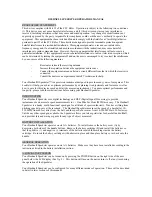
RF450 Spread Spectrum Radio
TABLE 4-2. Low Power Mode Settings
Setting Description
0
Low Power, disabled
1
LEDs dimmed, transceiver remains awake, transceiver is listening
to the Master's transmissions on every slot.
2
LEDs dimmed, transceiver sleeps every other slot
3
LEDs dimmed, transceiver sleeps 2 of 3 slots
4-31
LEDs dimmed, transceiver sleeps the number of slots
corresponding to the setting.
For example, with a setting of 31 the transceiver sleeps 30 of 31
slots.
Low power mode is used only in multi-point Slaves. Power
savings occur only when the Slave is linked. There are no power
savings when the Slave is transmitting data. Low power mode is
of little value when a Slave has a constant, high throughput.
4.6.10 Transmit Subnet ID Setting
In a multi-point network, a Slave or repeater will connect with the first repeater
or Master that it hears with the same Network ID. There are scenarios,
however, where communications need to be forced to follow a specific path.
For instance, the Subnet ID is particularly helpful to force two repeaters in the
same network to operate in series rather than in parallel; or, if desired, to force
Slaves to communicate to a specific repeater for load balancing purposes.
There are two components to the Subnet ID:
1.
Receive Subnet ID. This setting identifies which transceiver a repeater or
Slave will listen to.
2.
Transmit Subnet ID. This setting identifies the Network ID on which this
device transmits, and in turn which devices will listen to it. This setting is
only relevant to repeaters in multi-point networks.
The default setting for both receive and transmit is 15 which disables
SubNetwork functions. For the Master, this setting (15) causes the Master to
actually use 0. So, if the Subnet ID is to be used, the downstream radios that
need to connect to the Master will need their Receive Subnet ID set to 0.
Changing these settings on the Master is not recommended, under
normal circumstances. The Receive Subnet ID on the Master has
no effect on the network. If both Receive Subnet ID and Transmit
Subnet ID are set to 0, a mobile Slave can roam from subnet to
subnet and possibly from network to network.
4.6.11 Radio ID Setting
This setting allows a transceiver to be designated with an arbitrary, user-
selectable, 4-digit number which identifies the transceiver in diagnostics mode.
When used in conjunction with PakBus dataloggers, it is recommended that
NOTE
NOTES
12
Summary of Contents for RF450
Page 2: ......
Page 6: ......
Page 10: ......
Page 32: ...RF450 Spread Spectrum Radio 22...
Page 42: ...Appendix A Installation Scenarios A 10...
Page 45: ......
















































